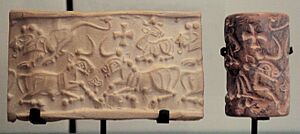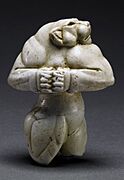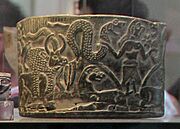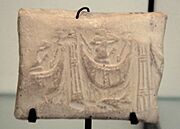Proto-Elamite (period) facts for kids

The Proto-Elamite period, also known as Susa III, was an important time in the ancient history of a region called Elam. This period lasted from about 3100 BC to 2700 BC. During this time, the Proto-Elamite sites became known as the oldest civilization in Iran. The Proto-Elamite script was an early writing system used briefly before a different type of writing, called Elamite cuneiform, became common.
A Look Back in Time
How It All Began
Between 8000 BC and 3700 BC, many small villages grew across an area known as the Fertile Crescent. These villages had plenty of food because of farming. To keep track of their extra food, people started using small, shaped clay pieces called "tokens." The oldest tokens found so far come from two places in Iran: Tepe Asiab and Ganj-i-Dareh Tepe.
Later, between 3700 BC and 2900 BC, the Mesopotamian civilization began to develop. During this time, new inventions appeared, like the plough (for farming), sailing boats, and ways to work with copper metal. People also started using clay tablets with simple pictures, called pictograms, to record business deals. These records were often kept by the temples.
Important Proto-Elamite Places
The most important places from the Proto-Elamite period are Susa and Anshan. Another key site is Tepe Sialk. Here, you can still see the only remaining Proto-Elamite ziggurat, which is a type of ancient temple tower.
Writing in the Proto-Elamite script has been found on clay tablets at Susa, as well as at Tepe Sofalin and Tepe Yahya. This writing system is still a mystery, as experts have not yet figured out how to read it.
It was once thought that the Proto-Elamites were the same people as the later Elamites. This was because they shared similar customs, like building ziggurats. Also, it seemed no large groups of people moved into the area between these two periods. However, since Proto-Elamite writing has been found in many more places, this idea is now less certain.
Proto-Elamite pottery, which dates back to the late 5th millennium BC, has also been discovered at Tepe Sialk. This is where the first form of writing in Iran was found on tablets from this time. The very first cylinder seals, which were used to make impressions on clay, also come from the Proto-Elamite period.
-
A kneeling bull holding a special pot, from the Proto-Elamite period (3100–2900 BC). This artwork is at the Metropolitan Museum of Art.
-
The Proto-Elamite Guennol Lioness, a small statue from around 3000–2800 BC.
Proto-Elamite Cylinder Seals
Proto-Elamite seals came after the seals of the Uruk period. They share many similar art styles. However, Proto-Elamite seals show more unique designs and look more lively.
-
A Susa III/Proto-Elamite cylinder seal from 3150–2800 BC, now at the Louvre Museum.
See also









